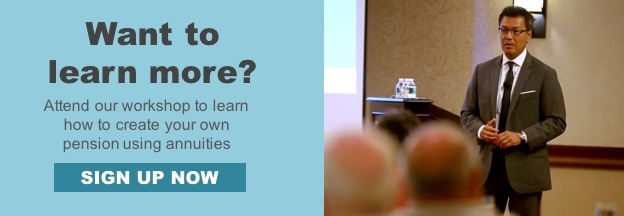4 min read
The Solution in Retirement: Dependable and Sustainable Income
By: Sam Liang Feb 22, 2018 2:19:27 PM

The fathers of the 401(k) plan as we know them today never intended it to replace the traditional pension plans most workers used to enjoy. But that’s exactly what’s happened over the last 30+ years, according to an article recently published in the Wall Street Journal.

The fathers of the 401(k) plan as we know them today never intended it to replace the traditional pension plans most workers used to enjoy. But that’s
exactly what’s happened.
The shift from traditional pensions to 401(k) plans was intended to leave workers in better control of their retirement. And it was a good sounding story. You could have your pension, but you could also save some of your money into a plan you controlled, select your own investment options in line with your risk profile, build up a pot of money, retire at some point, and withdraw money from your 401(k) to supplement your pension.
Presto! A successful retirement strategy.
The only problem is, the story turned out to be pure fiction!
Instead of supplementing pensions, many companies simply stopped offering them entirely and switched to 401(k) plans. Because workers were used to company pension plans, many workers didn’t fund their plans adequately over the years and weren’t very good at selecting their own investment options over time. Some took too much risk. Others took too little risk.
Last but not least, when it came time to retire and take income from their 401(k), most retirees had no idea how to do that in a safe, sustainable way to guarantee their money lasted the rest of their life.
So what’s the result of this mess? Well, I can tell you when many of our now clients first came to us, they were scared. They were scared of the markets. They were scared of running out of money. They were scared because most of the advice they saw out there didn’t seem to really address what they wanted.
They wanted something like a pension. They wanted something like Social Security. They wanted to know they wouldn’t run out of money halfway through their retirement.
If you are nearing retirement, or are enjoying retirement, ask yourself what is more important. Knowing that your bills and expenses are being met by a dependable and sustainable income stream? Or simply just having a big number on your 401(k) statements? If you’ve never worked with a professional to determine what is best, start with the following steps:
1. Figure out how much income you'll need every month. We call this your “burn rate.” It seems elementary, but you’ll be surprised at the number of people we sit with who don’t know that number. Your burn rate is not what you’ll need to get by, rather what you want so you can enjoy your retirement. It should include your essential expenses and your lifestyle expenses. After all, you’ve worked hard to earn it!
2. Next, figure out what income you'll have. Include things like Social Security, defined benefit plans or pensions, rental income, dividends, part-time work, etc.
3. Is there a shortfall? We call this the income gap.
4. Now you have facts to work with and can solve the biggest retirement dilemma: Where am I going to get dependable and sustainable income in retirement?
From here, your retirement advisor can work toward a model to address your concerns, such as: how to grow your savings to keep up with inflation, having enough set aside in an emergency fund, and how to best set aside some money to leave to your family. But the most critical concern is (you guessed it): Where will you get dependable and sustainable income in retirement? This is the foundation and bedrock of a good retirement income plan. Remember, a retirement income plan is a lot different than simply a bunch of retirement accounts.
At our firm, we like to think of the money in "buckets."
Bucket #1 is your bank savings. It’s not there to earn a lot in interest, but the goal is to have enough for emergencies. The rule of thumb is one year’s total expenses.
Bucket #2 is designed for growth and aimed to keep pace with inflation. This might be stock mutual funds, ETFs, or other growth-oriented assets. The goal, of course, is for these assets to go up, but we all know it can do down as well. If there is a downturn, and these assets have lost money, you don’t want to rely on this money for income. A few years of losses and income withdrawals can equal disaster.
Bucket #3 will be the bucket to produce dependable and sustainable income. If from the beginning, your advisor helped you determine your income gap, then we generally allocate a portion of the portfolio to produce about 10% more than the needed income. This will give the client added peace of mind that, in a down market, they’ll still have more than enough to pay their bills and enjoy retirement.
We’ve never met anyone who has said, “Hey, I got too much income!”
What Should You Do About The Coronavirus And Stock Market Volatility?
The financial markets took a big dip early this week over fears about the spreading coronavirus,...
4 New Tax Proposals That Could Shake Your Retirement Plan
Several of the suggested proposals in Biden’s tax plan could significantly affect retirees and how...